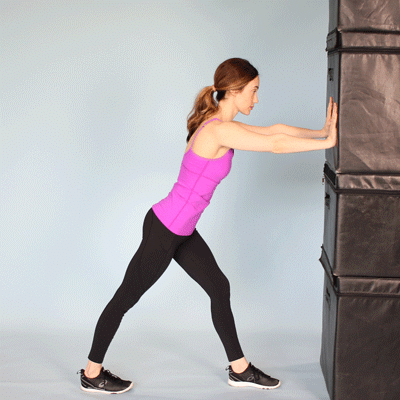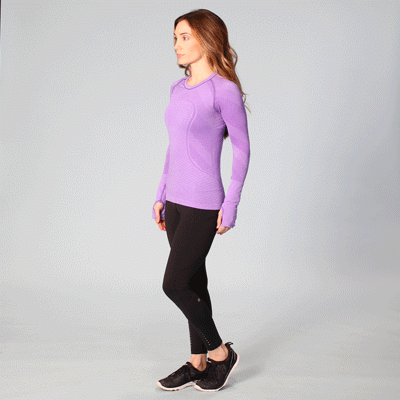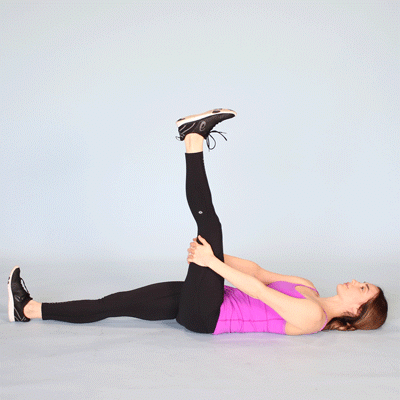Gentle stretching and other low impact exercises can strengthen the muscles that support your knee joint. Start by stretching your heel, calf, quadriceps, and hamstrings, and work up to half squats, calf raises, and other leg lift variations.
Whether you’re a competitive athlete, a weekend warrior, or a daily walker, dealing with knee pain can put a kink in your favorite activities.
This includes pain caused by:
- overuse
- osteoarthritis
- tendinitis
- bursitis
- meniscus tears
- sprained knee ligaments
Exercising a knee that’s injured or arthritic may seem counterintuitive, but exercise is better for your knee than keeping it still. Not moving your knee can cause it to stiffen, worsening the pain.
If your knee pain is due to an injury, surgery, or arthritis, gentle stretching and strengthening exercises may help ease the pain while improving your flexibility and range of motion.
Be sure to consult a healthcare professional or physical therapist before starting a new exercise routine. Above all else, listen to your body and stop immediately if you’re in severe pain or experiencing other unusual symptoms.
Lower-body stretching exercises may help improve the range of motion and flexibility in your knee joint. This can make it easier to move your knee.
Before stretching, try to spend at least 5 to 10 minutes warming up. Low-impact activities like cycling on a stationary bike, walking, or using an elliptical machine are good warmup options.
Once you’re warmed up, do the following stretches, and then repeat them after the knee-strengthening exercises. Try these stretches and exercises at least four to five times a week.
1. Heel and calf stretch
This stretch targets the muscles in your lower leg, specifically your calf muscles.

To do this stretch:
- Stand facing a wall.
- Place your hands on the wall and move one foot back as far as you can comfortably. The toes on both feet should be facing forward, heels flat, with a slight bend in your knees.
- Lean into the stretch and hold for 30 seconds. You should feel the stretch in your back leg.
- Change legs and repeat.
- Do this stretch twice on each leg.
2. Quadriceps stretch
This stretch targets your quadriceps, the muscles at the front of your thighs. Performing this move can help improve the flexibility in your hip flexors and quadricep muscles.

To do this stretch:
- Stand next to a wall or use a chair for support. Your feet should be shoulder-width apart.
- Bend one knee so that your foot goes up toward your glutes.
- Grab your ankle and gently pull it toward your glutes as comfortably as possible.
- Hold for 30 seconds.
- Return to the starting position and change legs.
- Repeat 2 times on each side.
3. Hamstring stretch
You should feel this stretch in the back of your leg and up to the base of your glutes. If you flex your foot, you may feel the stretch in your calves.

To do this stretch:
- For this stretch, you can use a mat to add cushioning under your back.
- Lie down on the floor or mat and straighten both legs. Or, if it’s more comfortable, you can bend both knees with your feet flat on the floor.
- Lift one leg off the floor.
- Place your hands behind your thigh but below the knee, and gently pull your knee toward your chest until you feel a slight stretch. This shouldn’t be painful.
- Hold for 30 seconds.
- Lower and change legs.
- Repeat twice on each side.
You can help reduce the stress on your knee joint by regularly working the muscles around your knee. To help strengthen your knees, focus on moves that work your hamstrings, quadriceps, glutes, and hip muscles.
4. Half squat
Half squats are an excellent way to strengthen your quadriceps, glutes, and hamstrings without straining your knees.
To do this exercise:
- Get into a standing squat position with your feet shoulder-width apart. Place your hands on your hips or out in front of you for balance.
- Looking straight ahead, slowly squat down about 10 inches. This is the halfway point to a full squat.
- Pause briefly, then stand up by pushing through your heels.
- Do 2 to 3 sets of 10 repetitions.
5. Calf raises
This exercise strengthens the back of your lower legs, which includes your calf muscles.
To do this exercise:
- Stand with your feet shoulder-width apart. Position yourself next to a wall or hold on to the back of a chair for support.
- Lift both your heels off the ground so that you’re standing on the balls of your feet.
- Slowly lower your heels to the starting position. Control is important with this exercise for strengthening your calf muscles.
- Do 2 to 3 sets of 10 repetitions.
6. Hamstring curl
The standing hamstring curl targets your hamstrings and glutes. It also requires core strength to keep your upper body and hips steady.
To do this exercise:
- Stand facing a wall or use a chair for support. Your feet should be hip-width apart.
- Lift one foot, bend your knee, and raise your heel toward the ceiling. Go as far as you can while keeping your upper body still and hips pointing forward.
- Hold for 5 to 10 seconds.
- Relax and lower to the starting position.
- Do 2 to 3 sets of 10 repetitions for each leg.
7. Leg extensions
Using your body weight to strengthen your quadriceps, rather than a weighted machine, helps keep added pressure off your knees.
To do this exercise:
- Sit up tall in a chair.
- Put your feet flat on the floor, hip-width apart.
- Look straight ahead, contract your thigh muscles, and extend one leg as high as possible without raising your buttocks off the chair.
- Pause, then lower to the starting position.
- Do 2 to 3 sets of 10 repetitions for each leg.
8. Straight leg raises
The straight leg raise strengthens your quadriceps and your hip flexor muscles. If you flex your foot at the end of the move, you should also feel your shins tighten.
As this exercise gets easier, you can add a 5-pound ankle weight and gradually work up to a heavier weight as you build strength in your legs.
To do this exercise:
- For this exercise, you can use a mat to add cushioning under your back.
- Lie down on the floor with one leg bent and one leg straight out in front of you.
- Contract the quadricep of your straight leg and slowly raise it off the floor until it’s the same height as your bent knee.
- Pause at the top for 5 seconds, then lower to the starting position.
- Do 2 to 3 sets of 10 repetitions for each leg.
9. Side leg raises
This exercise works your hip abductor muscles. Your hip abductor muscles, located on the outside of your hips, help you to stand, walk, and rotate your legs with ease. Strengthening them can help prevent and treat pain in the hips and knees.
As this exercise gets easier, add a 5-pound ankle weight and gradually work to a heavier weight as you build strength.
To do this exercise:
- Lie on your side with your legs stacked on top of each other. Cradle your head in your hand and place your other hand on the floor before you.
- Raise your top leg as high as you comfortably can. You should feel this on the side of your hips.
- Pause briefly at the top, then lower your leg.
- Do 2 to 3 sets of 10 repetitions for each leg.
10. Prone leg raises
This exercise works your hamstrings as well as your glutes. As this exercise gets easier, you can add a 5-pound ankle weight and gradually work up to a heavier weight as you build strength in your leg muscles.
To do this exercise:
- For this exercise, you can use a mat to add cushioning beneath you.
- Lie on your stomach with your legs straight out behind you. You can let your head rest on your arms.
- Engage your glute and hamstring muscles in your left leg and lift your leg as high as you comfortably can without causing pain. Be sure to keep your pelvic bones on the floor throughout this exercise.
- Hold your leg in the lifted position for 5 seconds.
- Lower your leg, rest for 2 seconds, then repeat.
- Do 2 to 3 sets of 10 repetitions for each leg.
Once you’ve built up your knee strength, consider adding low impact exercises to your routine. These exercises typically put less stress on your joints than high impact exercises, like running or jumping.
Examples of low impact exercises include:
Finding relief from knee pain depends on the underlying cause. In addition to home exercises, a healthcare professional may recommend:
- Applying ice if it provides relief
- Using a knee compression sleeve to decrease swelling and provide stability
- Using nonsteroidal anti-inflammatory drugs (NSAIDs), whether oral or topical, the first few days after injury
A physical therapist can develop and supervise an exercise program designed for your specific injury or symptoms.
Does walking help with knee pain?
Adopting a walking routine can help improve the strength and flexibility of the muscles around the knee joint. Start slowly, walking for just a few minutes on a treadmill or flat pathway.
You can gradually increase the intensity by extending the duration, upping the frequency, or adding a slight incline.
What exercises relieve knee pain?
Stick to low impact exercises that target the muscles around your knee joint, like your hamstrings and quadriceps. This can help support the knee joint and reduce tension.
What exercises strengthen knees?
Your quadriceps, hamstrings, and glutes all contribute to knee stability. You can help strengthen these muscles with:
- Calf raises
- Hamstring curls
- Leg extensions
- Lunges
- Step-ups
- Squats
What is the single best exercise for knee pain?
The best exercise for knee pain is the one you feel capable and comfortable doing. The specific injury or underlying condition you’re trying to improve also plays a significant role.
Always consult with a healthcare professional if you have questions or concerns.
Performing stretching and strengthening exercises that target the muscles that support your knees may help ease pain, improve range of motion and flexibility, and reduce the risk of future injuries.
With joint pain, it’s best to talk with a doctor or physical therapist before starting an exercise program. They can also recommend exercises and modifications based on your pain and the underlying cause.









